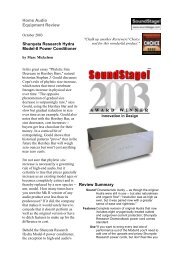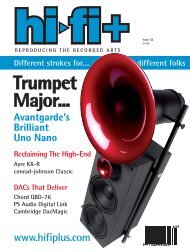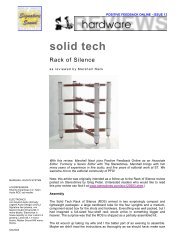R100 Review - Audio Note Singapore
R100 Review - Audio Note Singapore
R100 Review - Audio Note Singapore
Create successful ePaper yourself
Turn your PDF publications into a flip-book with our unique Google optimized e-Paper software.
Scot Markwell<br />
Equipment <strong>Review</strong><br />
Analog Capsules:<br />
Two great analog overachievers<br />
ZYX <strong>R100</strong>H Moving-Coil Phonograph Cartridge<br />
and Coph Nia MC Phono Preamplifier<br />
In these heady days of the best LP playback equipment that has<br />
ever existed on the planet, many who might otherwise want to get<br />
into (or re-enter) the world of vinyl are daunted or stopped cold by<br />
how much it costs to get really first-class sound. So many high-priced<br />
"The <strong>R100</strong>H renders music's foundation,<br />
be it orchestral, jazz, big band, or<br />
pop/rock, with a weight, precision, and<br />
realism that defies almost all others…"<br />
phono sections and moving-coil cartridges are now showcased so often<br />
in the press that you might think affordable components are in the minority<br />
or are hopelessly inferior to the high-priced spread. It's nice to read<br />
about these ambitious designs and what they can do, of course, but<br />
most consumers want to have their cake and eat it, too. This is a natural<br />
desire, but nearly impossible to attain. Nearly, I said. It<br />
is not completely impossible.<br />
Enter the Japanese ZYX <strong>R100</strong>H medium-output<br />
MC cartridge and the Swedish Coph Nia MC<br />
Phono Preamplifier. At $995 and $1295, respectively,<br />
these two products are placed somewhere<br />
in the bottom third of retail price structure for<br />
such devices. You can buy similar components<br />
for several hundred dollars less, but the pieces<br />
under consideration here are so good that their<br />
ultimate value is much higher than many similar<br />
components that are less expensive. In many<br />
respects, both of these products will not only<br />
keep up with much of the more expensive competition,<br />
but in some ways, they perform well above<br />
their price level, particularly the <strong>R100</strong>H cartridge.<br />
This cartridge initially gave me fits. I was, I must<br />
confess, somewhat prejudiced against it before I heard<br />
it, because I had not had the best of luck with its higher-priced, similarlooking<br />
brother, the <strong>R100</strong> Fuji FS, in Harry Pearson's system several<br />
months ago. That cartridge had seemed a bit dull and lacking in focus;<br />
we eventually returned it. And the same thing happened with the <strong>R100</strong>Hthat<br />
is, the subject of this review. When I first installed it, I could get nothing<br />
but a rather soft and overly laid-back sound that was lacking in<br />
instrumental weight and body, and had not much in the way of a true<br />
midbass foundation. The sound was thick, slow, and veiled.<br />
I tried several phono sections, including the Hagerman Trumpet,<br />
the Coph Nia under review, the Plinius M14, the Clearaudio Balance,<br />
and others. Each time, I did not have the patience to wait it out to be sure<br />
it didn't need more running in; I simply removed it and substituted another<br />
MC that I had on hand at the time. Finally I recognized that I was not<br />
giving the cartridge a fair chance. Others whose ears I trust report it as<br />
very good, indeed. So I put it into the system once more, this time in a<br />
true balanced configuration into Ralph Karsten's stunningly good<br />
AtmaSphere MP-1 all-differential, all-tube, full-function preamplifier.<br />
Well, I was stunned as soon as I set the needle down on the first<br />
record. I could not believe what I was hearing; I pretty much still do not.<br />
I know what you are thinking: that the AtmaSphere is a much better a<br />
phono section than the others, and therein lies the difference. It's true<br />
that the MP-1 is a superb preamplifier, but ultimately, this is a tale of<br />
proper adjustment and (unexpectedly long) cartridge break in.<br />
At .34 mV output, the <strong>R100</strong>H has enough signal capability so that it<br />
will exhibit a better overall signal-to-noise ratio in an MC phono stage than<br />
cartridges of lower output. But make no mistake-this is still a puny signal,<br />
in this era of line-level outputs of several volts. An illustrative story: The<br />
MP-1 I alluded to above, while sounding gloriously lifelike in many ways<br />
(and with over 60dB of overall gain for phono reproduction), nevertheless<br />
has audible tube rush discernable from the listening position at even medium<br />
playback volumes. Some will find this level of noise unacceptable. I<br />
decry it intellectually, but in practice, though it is a bit of a nuisance, I do<br />
not find it overly obtrusive. Not any more, any way. I remember being really<br />
irritated one day and complaining to Karsten about<br />
the hiss level. He didn't bat an eye, just asked me<br />
if the residual noise floor of the record was<br />
louder, at its softest point, than the tube hiss.<br />
I said that 95% of the time it was, and he pointed<br />
out that the tube hiss did not, therefore,<br />
make any real difference. My brain has trouble<br />
with this, but my ears are so entranced by<br />
the sound that I am no longer annoyed. I<br />
thought that this rather high noise level, to<br />
one accustomed to the almost-silent background<br />
of the solid-state Plinius M14 phono<br />
stage, would be an impediment to the recovery<br />
of fine detail from my records, but it turns out that<br />
that was not the case at all. The resolution of the<br />
system shone through the hiss of the tubes as if it<br />
was not there.<br />
How then, does this transparent (as in see-through acrylic body)<br />
little wonder of a cartridge sound? The best description I can summon is<br />
that it gives me more of a true sense of the music, its essence, if you will,<br />
"…if the recording is up the task, you<br />
will hear, with the <strong>R100</strong>H, a greater<br />
fidelity to violins, bass guitars, violas—the<br />
whole lot—than with almost<br />
any other MC I have experienced.”<br />
than anything else I have used in the past several years. To drive this<br />
point home, I want to reiterate that not only was I predisposed to dislike<br />
this cartridge, but it actually did sound decidedly less than impressive<br />
the first few times out. The difference, I remind you, lies in the fact that<br />
it has been played enough to be truly run-in, as well as being partnered<br />
with a superior phono stage—and I am referring not just to the expen-<br />
© Copyright 2004, Absolute Multimedia AVguide Monthly<br />
11
Equipment <strong>Review</strong><br />
sive AtmaSphere, but to the little Coph Nia, priced most reasonably, discussed<br />
below.<br />
Dynamic contrasts, in particular, are rendered in such a manner as<br />
to suggest real instruments and musicians, especially with the best<br />
Direct-to-Disc recordings, such as those from Sheffield Lad and Crystal<br />
Clear. The Sheffield Lab Prokofiev Excerpts D-to-D LP sounds so<br />
open and alive with the <strong>R100</strong>H as to start to suggest the presence<br />
of the orchestra and the sonically amazing MGM<br />
soundstage it was recorded on, warts and all. I<br />
have also been listening to several<br />
Japanese D-to-D recordings manufactured<br />
by Toshiba/EMI, and they are stunning<br />
in their transient impact, transparency,<br />
and faithfulness to the real thing. Take<br />
the "A" Train by The Third is a good<br />
example. The musicianship is a bit hokey,<br />
but all the various percussion and wind<br />
instruments sound alive and are possessed of a<br />
high degree of "snap" and a rightness to leading-edge transients<br />
that makes the music sound closer to live. Natural hall ambience<br />
is rendered with an ease and bloom that allows the instruments to<br />
bask in their own glow. If you are playing a pop/rock album, or anything<br />
recorded in a deadish studio environment, you can easily hear the artificial<br />
reverb that has been applied to the recording, especially if it is one<br />
of the old plate reverb units that have such wonderful trailing-edge signatures.<br />
There is less of a residual<br />
mechanical quality to the <strong>R100</strong>H than<br />
many of its MC brethren, including<br />
some that cost many, many times<br />
more. Music through this transducer<br />
has a presence and a vivacity that is<br />
neither unnaturally bright nor unnaturally<br />
projected; it is merely realistic<br />
and engrossing in the same manner<br />
as real music. While the <strong>R100</strong>H will never be described as a detailfreak's<br />
cartridge, it nevertheless manages to elicit enough information<br />
from the grooves that I do not cry for more. I do feel that I may be missing<br />
the very last word in resolution here, but the net effect is so well balanced<br />
that I can easily and willingly live with it.<br />
The <strong>R100</strong>H renders music's foundation, be it orchestral, jazz, big<br />
band, or pop/rock, with a weight, precision, and realism that defies<br />
almost all others, save the 47 Lab Miyabi, and that is four times the modest<br />
cost of the <strong>R100</strong>H. Along with this<br />
impressive reproduction of the lower<br />
frequencies comes a delicate balancing<br />
act with the rest of the musical spectrum<br />
in the sense that the <strong>R100</strong>H is<br />
never upset into intermodulation distortions<br />
when playing strong bass lines, as<br />
when reproducing a chorus singing at<br />
full tilt while deep and loud organ pedals<br />
are being played and held. The<br />
voices and the pedals both sound<br />
super-clean and remain correctly separated<br />
in the spatial and textural planes.<br />
There is a sweetness to massed<br />
strings that I have truly never heard rendered as well in my system. Not<br />
sugar-sweet, as if the notes had been dripped in honey, but with the natural<br />
rosin-y intensity of real music. Mind you, this quality is almost wholly<br />
dependant on the recording, rather than being a featured "sound" of<br />
the <strong>R100</strong>H, and if the record in question has poorly-recorded string<br />
instruments, then you will get that, no veiling or sugar-coating. However,<br />
if the recording is up the task, you will hear, with the <strong>R100</strong>H, a greater<br />
fidelity to violins, bass guitars, violas—the whole lot—than with almost<br />
any other MC I have experienced.<br />
Oh, I almost forgot: I tried this cartridge with a<br />
variety of resistive loads on both the<br />
AtmaSphere MP-1 and the Coph<br />
Nia, and I always liked 47K/ohms<br />
best. Your response, based on your<br />
taste and system balance, may be<br />
different, but I felt that this "wideopen"<br />
loading brought out the cartridge's<br />
best performance in<br />
dynamics and treble extension,<br />
without imparting any overly-etched<br />
quality to the upper midrange.<br />
You may now be wondering<br />
where the Coph Nia MC phono<br />
section figures in all of this. I did not intend this review to<br />
partner these two pieces as a front-end system, though they do sound<br />
exceptionally well in such a configuration. Rather, I have put the two<br />
products together to illustrate the fact that there exists, in a lower price<br />
structure than is the norm for such quality, both a modern MC cartridge<br />
and MC phono section of some distinction.<br />
That being said, the<br />
"This phono stage is so quiet, and<br />
blessed with such a see-through quality,<br />
that it manages to retrieve every<br />
nuance of a cartridge's performance<br />
envelope and paint a different sonic<br />
palette for each one."<br />
Coph Nia, when partnered<br />
with the <strong>R100</strong>H (or any<br />
other MC that I tried it with),<br />
was as silent as a tomb. It<br />
does not sound quite as<br />
good as the AtmaSphere<br />
MP-1, but at just over<br />
1/10th the price of that twopiece<br />
tubed unit, this slim and tidy solid-state phono stage is way better<br />
than 1/10th as good. Used with the <strong>R100</strong>, the Coph easily allowed the<br />
musicality and transparency of the cartridge to come through.<br />
So, yes, this MC stage is another reasonably priced gem. It is good<br />
enough to use with your choice of an MC cartridge, and you can upgrade<br />
to even more expensive ones and still get good results from the Coph<br />
Nia. It is transparent enough to easily pass on a given transducer's sonic<br />
signature. And that is, in fact, the hallmark of the Coph Nia: transparency.<br />
This phono stage is so quiet, and blessed with such a see-through<br />
quality, that it manages to<br />
retrieve every nuance of a cartridge's<br />
performance envelope<br />
and paint a different sonic<br />
palette for each one. It is also<br />
almost overly sweet in the<br />
upper midrange and lower treble,<br />
to the point of seductiveness<br />
and at the slight expense<br />
of accuracy. But in many systems,<br />
especially those built at<br />
this price point (say around<br />
$7000-$9000 for a full system<br />
including a decent CD player),<br />
this quality will seem a natural<br />
balm to many recordings.<br />
Especially crystalline and grainless<br />
in the extreme highs, if<br />
ever-so-slightly soft, the Coph Nia falls down in comparison to the very<br />
best only in its rendition of the highest musical harmonics and its slight<br />
lack of weight in the mid- and lower bass.<br />
These are not serious failings. To put things in perspective, if you<br />
© Copyright 2004, Absolute Multimedia AVguide Monthly<br />
12
Equipment <strong>Review</strong><br />
listen to the Coph Nia in Harry Pearson's reference system, you can<br />
easily hear that is a tad light in the bass and that it is not as harmonically<br />
developed as, say, the Groove+ (which sells for almost five times as<br />
much), or the AtmaSphere MP-1 in my system. On the other hand, in a<br />
bit more modest system, the Coph Nia acquits itself well, indeed, with a<br />
lightness and deftness of touch that brings natural detail to the fore and<br />
then integrates it into the overall sonic cloth without calling undue attention<br />
to any part of the frequency or spatial spectra. It is more of a graceful<br />
Fred Astaire dancer with the music, if you will, than a powerful Gene<br />
Kelly. Maybe Astaire could stand to gain a couple of pounds, but his fluidity<br />
and grace are unsurpassed; beside Astaire, Kelly appears almost<br />
clumsy and slow. The Coph Nia's tonal balance, while lean, is unfailingly<br />
honest and squeaky-clean; it sings with a true voice, if one perhaps<br />
not quite as full-blooded as some of the competition.<br />
The Clearaudio Balance, for instance, at almost exactly the same<br />
price, is another compact MC stage of solid-state origin, although it<br />
comes with a separate dual-mono power supply. As might be expected,<br />
it does hit harder in the bass and can seem to have a wider dynamic<br />
range than the Coph, but often at the expense of sounding, in comparison,<br />
a bit contrived or overdone. It can also, at times, sound more exciting<br />
and spectacular. Perhaps just a bit too exciting at times. The Plinius<br />
Jarrah, at about $800, is in between: It is not as sweet as the Coph Nia,<br />
but it does have more of the dynamic wallop of the Clearaudio. Yet, sideby-side<br />
with the Coph, it loses in terms of smoothness of the highs and<br />
transparency to source; the Coph Nia is a little more refined, with more<br />
of a see-though quality to its reproduction of the soundstage.<br />
So it is fully competitive in its market segment, this little phono box;<br />
its selection by a purchaser will be based not just on its price, but on its<br />
sophisticated and seductive style of phonograph-record reproduction. If<br />
your taste in LP reproduction leans to the side of transparency, sweetness<br />
of texture, low noise, a mid-hall perspective, with an overall polish<br />
of sophistication and lack of grain, you will find much to admire here.<br />
Likewise, if you place more stock in hard-hitting dynamics and a more<br />
spectacular and close-to presentation, then you may wish to look elsewhere.<br />
In the final analysis, however, the Coph Nia will leave you smiling<br />
and wanting more, while its rowdier stablemates may well leave you<br />
wanting a break. The Coph Nia is a great value for the money and a winner<br />
in most respects. And if you have a good subwoofer in your system,<br />
and know how to adjust it, then its slight lack of bass weight is easily<br />
compensated for.<br />
I remain bedazzled and amazed that we have such a plethora<br />
of superb phono-reproduction equipment available, and at<br />
almost every price range. The ZYX <strong>R100</strong>H MC cartridge and the<br />
Coph Nia MC phono section are by no means cheap or casual<br />
products. But they are both genuinely high value, in the sense<br />
that you are getting a whopping lot of innate goodness and musicality<br />
in both products. The <strong>R100</strong>H is an out-of-the-ballpark home<br />
run, as far as I am concerned (though its performance doubtless<br />
will, to some degree, vary depending on the level of the rest of<br />
your phono equipment; it sounds great with affordable gear and<br />
stellar with the best stuff), and the Coph Nia is an excellent unit<br />
for a refined, reasonably scaled system. You might be able to get<br />
both for a not-inconsiderable discount (I have seen the Coph Nia<br />
for less than a grand, for instance).<br />
High-End performance at reasonably accessible prices.<br />
Bread-and-butter products whose savor places them well above<br />
their station.<br />
Specifications<br />
ZYX <strong>R100</strong>H MC Cartridge<br />
Type: Moving-coil (dynamic)<br />
Output Voltage: 0.24mV (H = 0.48mV) [3.54cm/sec., 1kHz] or<br />
0.34mV (H=0.68mV) [5.0cm/sec., 1kHz]<br />
Frequency Response/( +/- 1dB): 10Hz ~ 80kHz (20Hz ~ 20kHz)<br />
10Hz~100kHz (20Hz~20kHz)<br />
Channel Separation > 30dB [1kHz]<br />
Channel Separation < 0.5dB [1kHz]<br />
Recommended Tracking Force: 2.0gm [20 ~ 25 degrees Celsius]<br />
Tracking Force Range: 1.7 ~ 2.5gm<br />
Compliance horizontal (vertical): 15 x 10-6 cm/dyne (12 x 10-6<br />
cm/dyne)<br />
Trackability: > 80ƒÊm/2.0gm<br />
Internal Impedance: 4 ohms (H = 8 ohms) 3.5 ohms (SH, H = 7.0<br />
ohms)<br />
Recommended Load Impedance: > 100 ohms<br />
Cantilever Material: Boron rod 0.3mm dia.<br />
Diamond Square Rod: 0.22mm sq.<br />
Stylus: Microridge Solid Diamond 0.07mm sq.<br />
Net Weight: R-100 4.2gm<br />
Coph Nia MC Phono Section<br />
Variable input load from 22 Ohms to 47k Ohms<br />
Gain: 60dB<br />
Features:<br />
Very accurate passive RIAA equalization<br />
Ultra low noise<br />
Phase correct<br />
Separate power supplies for each channel<br />
Mains filter<br />
Only highest quality audio capacitors<br />
Shielded internal signal cables<br />
Gold-plated RCA in and outputs<br />
Dimensions: W 3,5" / 9cm H 3,5" / 9cm D 12" / 30cm<br />
Weight: 5 lbs / 2,2kg<br />
Associated Equipment<br />
VPI HW-19 MK IV turntable w/VPI JMW Memorial 10.5 arm; Clearaudio<br />
Harmony Wood and Insider Master Reference Wood, Van Den Hul<br />
Colibri, and Madrigal Carnegie 1 MC cartridges; Plinius M-14 and<br />
Clearaudio Balance(SS), Hagerman Trumpet (tubed), and AtmaSphere<br />
MP-1 (tubed) phono sections; Plinius M-16 (SS) and AtmaSphere MP-<br />
1 (tubed) line stages; Ayon <strong>Audio</strong> Classic 32B, Viva 300B, and Vaic<br />
VV52 B SET amplifiers; Tom Evans <strong>Audio</strong> Design Soul 30 wpc Single<br />
Ended Tetrode (tubed) amplifier; VAC PA 100/100 tubed push-pull<br />
amplifier; Forsell Air-Bearing CD Transport and EAD Theatermaster<br />
DAC; Reference 3A Royal Virtuoso, Horning Agathon, and Living Voice<br />
Avatar OBX loudspeakers; Chase Technologies CH-1 passive surround<br />
decoder with a pair of small Radio Shack Minimus speakers for<br />
surround sound, SLM/Janis subwoofer with Crown Macro Reference<br />
amplifier; Siltech Gen III, <strong>Audio</strong> Magic, Acoustic Zen, and Stealth<br />
Technologies cables, Arcici Suspense Rack.<br />
Manufacturer Information<br />
Both products distributed and sold in the USA by:<br />
Music Direct<br />
318 N Laflin St., Chicago, Illinois 60607<br />
Phone: 800-449-8333 or 312-433-0200<br />
Fax: 312-433-0011<br />
twolff@amusicdirect.com<br />
www.amusicdirect.com/default.asp<br />
Prices: Coph Nia MC Phono Stage: $1295; ZYX <strong>R100</strong> medium output:<br />
$995<br />
On the Web:<br />
ZYX cartridges<br />
www.bertrandaudio.com/Products/ZYXPhono/ZYXPhono.htm<br />
Coph Nia<br />
hem.fyristorg.com/cophnia<br />
© Copyright 2004, Absolute Multimedia AVguide Monthly<br />
13



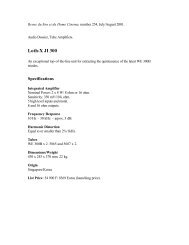
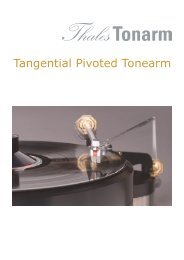
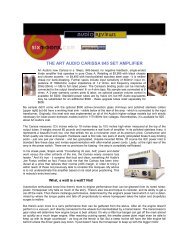
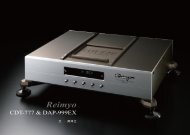

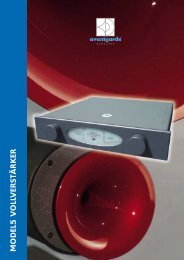
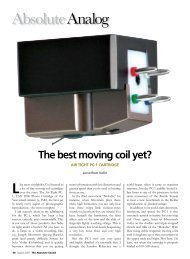
![DAP-999 EX Limited [pdf] - Audio Note Singapore](https://img.yumpu.com/27191044/1/190x253/dap-999-ex-limited-pdf-audio-note-singapore.jpg?quality=85)
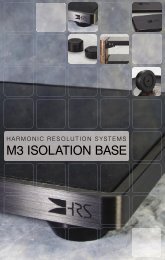
![Harmonix CS-120 Improved-Version [pdf]](https://img.yumpu.com/24411255/1/184x260/harmonix-cs-120-improved-version-pdf.jpg?quality=85)
